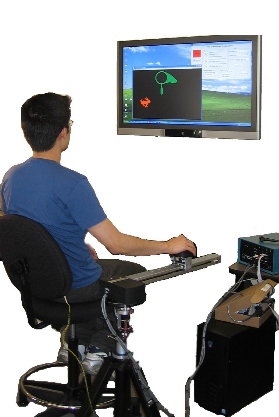Automated Upper Extremity Rehabilitation for Stroke Patients Using a Partially Observable Markov Decision Process

This project aims to develop a real-time system that guides stroke patients during upper extremity rehabilitation. The system automatically modifies exercise parameters to account for the specific needs and abilities of different individuals. The system uses a partially observable Markov decision (POMDP) model of a rehabilitation exercise that can capture this form of customization.
This project is in collaboration with the Intelligent Assistive Technology and Systems Lab, the University of Toronto and Quanser, inc.
Read more details about this project from Quanser and IATSL.
Paper
More details can be found by reading the following papers :
Patricia Kan, Rajibul Huq, Jesse Hoey, Robby Goetschalckx and Alex Mihailidis The development of an adaptive upper-limb stroke rehabilitation robotic system. Journal of NeuroEngineering and Rehabilitation, 8, 33, 2011 (bibtex)Rajibul Huq, Patricia Kan, Robby Goetschalckx, Debbie Hebert, Jesse Hoey and Alex Mihailidis A Decision-Theoretic Approach in the Design of an Adaptive Upper-Limb Stroke Rehabilitation Robot. Proc. of International Conference on Rehabilitation Robotics, Zurich, Switzerland, 2011 (bibtex)Robby Goetschalckx, Olana Missura, Jesse Hoey and Thomas Gaertner Games with Dynamic Difficulty Adjustment using POMDPs. ICML 2010 Workshop on Machine Learning and Games, Haifa, Israel, 2010 (bibtex)Patricia Kan, Jesse Hoey and Alex Mihailidis Automated upper extremity rehabilitation for stroke patients using a partially observable Markov decision process. AAAI 2008 Fall Symposium on AI in Eldercare, 2008 (bibtex) (see
AAAI 2008 Fall Symposium on AI in Eldercare, 2008)

